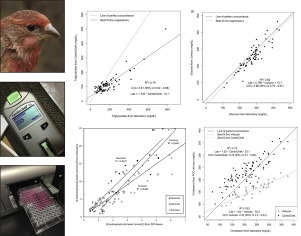当前位置:
X-MOL 学术
›
Comp. Biochem. Physiol. A Mol. Integr. Physiol.
›
论文详情
Our official English website, www.x-mol.net, welcomes your feedback! (Note: you will need to create a separate account there.)
Point-of-care blood analyzers measure the nutritional state of eighteen free-living bird species.
Comparative Biochemistry and Physiology A: Molecular & Integrative Physiology ( IF 2.3 ) Pub Date : 2019-10-30 , DOI: 10.1016/j.cbpa.2019.110594 Ana Morales 1 , Barbara Frei 2 , Casey Leung 1 , Rodger Titman 1 , Shannon Whelan 1 , Z Morgan Benowitz-Fredericks 3 , Kyle H Elliott 1
Comparative Biochemistry and Physiology A: Molecular & Integrative Physiology ( IF 2.3 ) Pub Date : 2019-10-30 , DOI: 10.1016/j.cbpa.2019.110594 Ana Morales 1 , Barbara Frei 2 , Casey Leung 1 , Rodger Titman 1 , Shannon Whelan 1 , Z Morgan Benowitz-Fredericks 3 , Kyle H Elliott 1
Affiliation

|
Point-of-care devices offer the potential to democratize a suite of physiological endpoints and assess the nutritional state of wild animals through plasma metabolite profiling. Measurements of plasma metabolites typically occur on frozen tissue in the laboratory, thus dissociating measurements from field observations. Point-of-care devices, widely used in veterinary and human medicine, provide rapid results (seconds or minutes) allowing in situ measurements of wild animals in remote areas without the need for access to freezers. Using point-of-care devices, we measured glucose, triglyceride, cholesterol and β-hydroxybutyrate levels in plasma from 18 wild bird species spanning nine families and three orders. The values from six different point-of-care devices correlated strongly with one another, and with traditional laboratory measurements from stored plasma (R2 = 0.70-0.90). Although POC devices provided accurate relative values in wild birds, absolute values varied from laboratory measurements by up to 50% illustrating the need for calibration equations. Furthermore, three case studies showed the potential for point-of-care devices at research stations where participants do not have access to a lab and sample preservation is difficult: (i) at a remote seabird colony, birds that were provided with supplemental food had higher levels of glucose and lower β-hydroxybutyrate and cholesterol levels than unfed birds, suggesting they were in a better nutritional state; (ii) at a migration monitoring station, levels of triglycerides of two migratory songbirds increased with time of day, implying that they were fattening during stopover; and (iii) for diving seabirds, individuals that worked harder (shorter surface intervals) had higher glucose and lower β-hydroxybutyrate implying that nutritional state is an index of foraging effort and success. We demonstrate that point-of-care devices, once validated, can provide accurate measurements of the nutritional state of wild birds. Such real-time measurements can aid in ecological research and monitoring, care of wildlife at rehabilitation centres, and in veterinary medicine of exotics.
中文翻译:

即时护理血液分析仪可测量18种自由生存鸟类的营养状况。
即时医疗设备可通过一系列血浆代谢物谱分析,使一系列生理指标民主化并评估野生动物的营养状况。血浆代谢物的测量通常在实验室的冷冻组织中进行,因此与现场观察结果分离。现场护理设备广泛用于兽医和人类医学,可提供快速的结果(几秒钟或几分钟),从而可以对偏远地区的野生动物进行现场测量,而无需使用冰柜。使用现场护理设备,我们测量了来自9个科和3个顺序的18种野生鸟类的血浆中的葡萄糖,甘油三酸酯,胆固醇和β-羟基丁酸酯水平。六种不同的即时护理设备的价值相互之间有着很强的相关性,并采用传统的实验室存储血浆测量值(R2 = 0.70-0.90)。尽管POC设备在野禽中提供了准确的相对值,但从实验室测量值得出的绝对值变化高达50%,说明需要校准方程式。此外,三个案例研究表明,在研究人员无法访问实验室且难以保存样品的研究站使用现场护理设备的可能性:(i)在偏远的海鸟殖民地,向其提供补充食物的鸟类与未喂养的鸟类相比,葡萄糖水平更高,而β-羟基丁酸酯和胆固醇水平更低,表明它们处于更好的营养状态;(ii)在移徙监测站,两只迁徙鸣禽的甘油三酸酯水平随一天的时间增加,这表明它们在中途停留时会发胖;(iii)对于潜水的海鸟来说,工作更努力(更短的水面间隔)的个体具有更高的葡萄糖和更低的β-羟基丁酸酯,这表明营养状态是觅食努力和成功的指标。我们证明,即时检验设备一旦得到验证,就可以提供野生鸟类营养状况的准确测量值。这种实时测量可以帮助进行生态研究和监测,在康复中心对野生动植物进行护理以及对外来动物进行兽医治疗。
更新日期:2019-10-30
中文翻译:

即时护理血液分析仪可测量18种自由生存鸟类的营养状况。
即时医疗设备可通过一系列血浆代谢物谱分析,使一系列生理指标民主化并评估野生动物的营养状况。血浆代谢物的测量通常在实验室的冷冻组织中进行,因此与现场观察结果分离。现场护理设备广泛用于兽医和人类医学,可提供快速的结果(几秒钟或几分钟),从而可以对偏远地区的野生动物进行现场测量,而无需使用冰柜。使用现场护理设备,我们测量了来自9个科和3个顺序的18种野生鸟类的血浆中的葡萄糖,甘油三酸酯,胆固醇和β-羟基丁酸酯水平。六种不同的即时护理设备的价值相互之间有着很强的相关性,并采用传统的实验室存储血浆测量值(R2 = 0.70-0.90)。尽管POC设备在野禽中提供了准确的相对值,但从实验室测量值得出的绝对值变化高达50%,说明需要校准方程式。此外,三个案例研究表明,在研究人员无法访问实验室且难以保存样品的研究站使用现场护理设备的可能性:(i)在偏远的海鸟殖民地,向其提供补充食物的鸟类与未喂养的鸟类相比,葡萄糖水平更高,而β-羟基丁酸酯和胆固醇水平更低,表明它们处于更好的营养状态;(ii)在移徙监测站,两只迁徙鸣禽的甘油三酸酯水平随一天的时间增加,这表明它们在中途停留时会发胖;(iii)对于潜水的海鸟来说,工作更努力(更短的水面间隔)的个体具有更高的葡萄糖和更低的β-羟基丁酸酯,这表明营养状态是觅食努力和成功的指标。我们证明,即时检验设备一旦得到验证,就可以提供野生鸟类营养状况的准确测量值。这种实时测量可以帮助进行生态研究和监测,在康复中心对野生动植物进行护理以及对外来动物进行兽医治疗。



























 京公网安备 11010802027423号
京公网安备 11010802027423号